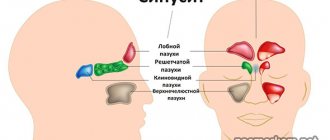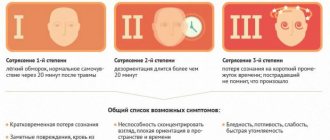Characteristics of the disease
Hypothyroidism in children - photo:
Thyroid hormones, which are responsible for the mental and physical development of the child, are produced in the thyroid gland already from the 12th week of the child’s intrauterine life.
This does not mean that before that his body developed without them, it’s just that until the 12th week the embryo had enough of the hormones that were in the mother’s body.
If hypothyroidism develops at such a young age, its consequences are usually irreversible, and even the death of the baby is possible.
What is hypothyroidism
The disease is characterized by insufficiency of the thyroid gland, in which little thyroid hormones are produced. It is worth saying that the course of hypothyroidism in children differs from the clinical picture of the disease in adults.
In the first weeks of intrauterine development, the fetus receives maternal hormones. From the third month, the baby’s own thyroid gland begins to function, so it depends less on maternal hormones.
Deficiency of thyroid hormones in children leads to insufficient development and mental retardation, therefore, already in the first days of life, the child undergoes testing of the concentration of T4, TSH, and thyroglobulin.
By nature, childhood hypothyroidism can be congenital or acquired, and depending on the severity of the symptoms of hypothyroidism in children, they distinguish between manifest, transient and subclinical. Depending on the pathology of hormone secretion, hypothalamic, thyroidogenic and pituitary hormones are distinguished.
How is it classified?
Hypothyroidism can be thyroidogenic, another name is primary; pituitary or secondary and hypothalamic - tertiary. The severity of the disease can be transient, subclinical and manifest.
Congenital pathology of the thyroid gland occurs in 1 case per 4,000 normal children. An inexplicable ratio of sick children relative to gender has also been recorded - girls are born with hypothyroidism 2 times more often than boys .
Read about the symptoms and treatment of hemolytic-uremic syndrome in children here.
Diagnosis
At the appointment, the specialist will ask a few questions, after which he will offer to undergo a series of examinations. What tests are needed to determine subclinical hypothyroidism?
- Study of the thyroid hormone level of the thyroid gland. However, passing this analysis is not sufficient, because hormone levels decrease rather slowly.
- Determination of the presence of antibodies to thyroglobulin, thyroid peroxidase.
- Blood test for the concentration of thyroid-stimulating hormone. This is the most informative survey.
- One of the mandatory methods for detecting subclinical hypothyroidism is scintigraphy.
In addition, in some cases additional research is required. If the doctor doubts the indicators identified during the procedures described above, then the following is prescribed:
- Ultrasound of the thyroid gland, which allows you to determine the organ parameters and tissue structure;
- Ultrasound of the abdominal cavity is mandatory for obvious signs of subclinical hypothyroidism;
- Chest radiography is mandatory if the described disease is suspected in children;
- electrocardiography - will determine the extent to which thyroid disease pathology affects the heart.
After completing all the necessary measures and identifying subclinical hypothyroidism in children, the necessary treatment is prescribed.
Reasons for appearance
One of the reasons for the appearance of hypothyroidism in newborns is heredity .
That is, the tendency to pathology is transmitted at the genetic level from one of the parents.
Most often, newborns experience thyroid hypothyroidism . It is caused by various conditions of the thyroid gland itself: it can be displaced, underdeveloped or completely absent. Violation of the development of this organ in the body of the embryo is caused by a number of reasons:
- Exposure to high levels of radiation during pregnancy or poor environmental conditions.
- Complete absence of iodine in the diet of a pregnant woman.
- The presence of infectious diseases during pregnancy.
- Treatment during pregnancy with thyreostatics, tranquilizers, bromides, and drugs containing lithium salts.
- Autoimmune thyroiditis.
- Endemic goiter.
- In 10% of cases, there is a failure in the synthesis of thyroid hormones.
Pituitary and hypothalamic hypothyroidism are caused by prenatally developed abnormalities in the pituitary gland or hypothalamus.
In cases of acquired hypothyroidism, there is injury to the pituitary gland or thyroid gland. This is possible during surgery or infectious organ damage.
Hypothyroidism: congenital and acquired
At the moment, congenital and acquired hypothyroidism are distinguished. In the first case, every two children in 2000 births suffer from the problem. In 15%, the disease is inherited, sometimes due to dysgenesis of the gland or abnormal production of hormones.
If the mother has iodine deficiency or hypothyroidism during pregnancy, the consequences for the child can be quite dangerous. In particular, congenital hypothyroidism may manifest itself with subsequent complications. But only if the expectant mother has not undergone replacement therapy.
Congenital hypothyroidism develops due to autoimmune thyroiditis, although it often manifests itself in adolescence and adulthood. Moreover, in 50% of cases, one of the relatives has the same problem. Other common causes of the disease include acute iodine deficiency.
Also, an acquired form of pathology occurs when the pituitary gland or thyroid gland is damaged, neoplasms, injuries, operations and inflammatory processes.
The main thing is to understand that the younger the child’s age, the more dangerous the disease is for his health, because The presence of hypothyroidism leads to disruption of many metabolic processes and developmental delays.
Symptoms in children
It is worth noting that in children, especially newborns, the symptoms of the disease are less pronounced. But usually they manifest themselves in the following:
- late stage of labor;
- heavy weight of the baby;
- swelling of the face, tongue and limbs;
- rough crying;
- heavy breathing and shortness of breath;
- umbilical hernia;
- prolonged jaundice;
- lethargy, fatigue, apathy;
- late appearance of the first teeth;
- muscle weakness.
Every year, the manifestations of the disease become more pronounced and brighter, and the child’s condition worsens. Adolescents may suffer from mental and physical development delays and obesity.
Diagnosis of the disease
Early diagnosis of hypothyroidism and determination of its type and severity is the first step towards normalizing the child’s condition.
Several techniques are usually used:
- Routine screening. Thanks to the study, the presence of the disease can be determined even before the first pronounced symptoms appear. If the test is positive, the doctor orders a blood test.
- Functional tests with blood sampling to determine serum TSH levels . Such an analysis of TSH levels helps determine how correctly and fully the thyroid gland is functioning.
- Ultrasound. This research method is prescribed to clarify the diagnosis. With its help, it is possible to study the size of the thyroid gland, determine any changes in the organ and the presence of deviations from the norm.
Once the diagnosis is confirmed, the patient will have to carry out diagnostics and attend preventive examinations every year.
How to recognize pathology?
Hypothyroidism tends to become more severe as the baby gets older.
In children under one year of age, the signs of the disease are not clearly expressed:
- As a rule, children with hypothyroidism are born late - at about 41-42 weeks.
- The child is born with increased weight; at the time of birth it is 3.5-4 kg .
- Swelling is observed on the face, tongue and fingers.
- The child's breathing is heavy and intermittent.
- The voice is low and quite rough for a newborn.
- The wound on the navel heals very slowly.
- The skin has a yellow tint , which indicates a chronic form of jaundice.
Over time, the manifestations of hypothyroidism become more noticeable and vivid.
The fact is that during breastfeeding, hormonal replacement of deficient thyroid hormones occurs with breast milk.
After stopping feeding or as the child grows up, the symptoms intensify . So in older children the following occurs:
- Somatic and psychological inhibition of development - the child is constantly sleepy, muscle tone is weak, the child is inhibited in movements, in addition, he begins to lag behind his peers in height and weight.
- The fontanelle closes late compared to normal children.
- Teeth begin to cut after 2-3 years .
- The child begins to make attempts to sit and stand late.
- As the child ages, there is a lack of interest in the world around him. Such children have difficulty making contact with people and rarely speak much .
- The child may have heart problems because the heart muscle is weakened.
- The skin is pale and dry.
- Hair is thin and brittle.
- The child has a constant body temperature slightly below normal .
- Frequent constipation occurs.
What are the consequences of a hematoma on the head of a newborn after childbirth? Find out the answer right now.
What danger does it pose and what consequences does it lead to?
Congenital hypothyroidism is dangerous because when it occurs in utero, it degenerates into cretinism, manifested by dementia and disruption of the central nervous system, that is, the child grows up mentally retarded .
Physically, the disease affects the patient’s skeleton, he remains small, there may even be dwarfism, the psyche, hearing, and speech are impaired.
The gonads remain in an underdeveloped state.
A mild form of the disease usually appears after 2 years . The child becomes inhibited, withdrawn, and does not make contact well. Significant weight gain is often observed, and puberty is delayed.
Possible complications
Hypothyroidism is considered a dangerous disease, and if not treated promptly it causes the following complications:
- disruption of natural metabolism in the body;
- mental retardation;
- problems with the cardiovascular system (heart failure, arrhythmia, etc.);
- violation of swallowing and respiratory function;
- obesity;
- violations of the child’s physical development;
- deterioration of immunity and, as a result, frequent infectious diseases.
Very often, with hypothyroidism, patients fall into a hypothyroid coma.
In this case, there is a possibility of death.
Diagnostic methods
To diagnose the disease in the early stages of pregnancy, screening - this is an ultrasound examination. It differs from conventional ultrasound in a more detailed reflection of the organs of the mother and child.
The mother's blood is then tested to determine the presence and levels of necessary hormones .
The thyroid gland is examined for the production of thyroid hormones.
After the baby is born, an ultrasound examination of the thyroid gland is performed to determine the pathology. During the same period, an x-ray examination of the newborn’s bones is prescribed in order to determine the severity of the disease.
Diagnostics
In some cases, patients may have no visible symptoms at all, so the pathology can only be diagnosed using a laboratory blood test. The latter includes the study of biomaterial for general, biochemical, and immunological parameters.
It is very important to determine the level of thyroid hormones (TSH, T3, T4, etc.). This diagnosis allows you to find abnormalities in newborn babies.
For older children, the following instrumental methods can be used:
- ultrasound examination of the organ;
- CT and MRI of the brain;
- scintigraphy;
- radiography of the musculoskeletal system.
During the last type of research, doctors determine how underdeveloped the patient’s skeleton is. Abnormalities during intrauterine development can be detected using ultrasound screening. The quality of the diagnosis directly depends on the effectiveness of treatment.
Treatment
To prevent mental retardation, treatment begins immediately after the birth of the child.
It is prescribed only by a doctor, after carrying out all diagnostic measures and assessing the severity and form of the disease.
In the vast majority of cases, the patient is prescribed a drug that replaces the missing hormone - sodium levothyroxine . Dosage and regimen of use are individual. The period of application is lifelong.
A biochemical test of the patient's blood is regularly performed to assess changes in the level of hormones in the blood, in order to adjust the dose of medications.
Forecast and preventive measures
If treatment begins on time, that is, immediately after birth, and the dosage of levothyroxine is prescribed adequately to the severity of the disease, then the prognosis is quite positive, up to the complete elimination of the manifestations of hypothyroidism. The child grows without any mental, mental or physical abnormalities.
If treatment was absent, or carried out incorrectly, or at the wrong time, the child remains disabled for life, and in severe cases of the disease, dies.
To prevent hypothyroidism from developing in utero, during pregnancy :
- Consume iodine . The dosage is prescribed by the doctor monitoring the pregnancy.
- Do screening .
In the treatment of hypothyroidism, the main thing is timeliness , careful attention to pregnancy and the newborn. If these conditions are met, the child can be saved and even completely cured.
Read about the signs of increased intracranial pressure in infants here.
About the treatment of hypothyroidism in children in this video:
We kindly ask you not to self-medicate. Make an appointment with a doctor!
Hypothyroidism in children is not as common as in adults. The child's body is actively growing. The thyroid gland is part of the body's neuroendocrine system. It produces hormones that participate in metabolic processes. If gland function decreases, the condition is called hypothyroidism. This pathology can be congenital or acquired. It is important that if left untreated, hypothyroidism can lead to serious consequences, including the child being declared disabled. What is the etiology, clinical picture and treatment of childhood hypothyroidism?
Subclinical form
Subclinical hypothyroidism in children is most often observed in children 2-4 years old. Its picture, especially when conducting a blood test, is quite clear: the T4 hormone is within normal limits, while TSH is increased. This disease can be detected in girls for the first time at the age of 5, but in childhood it can be treated quite effectively.
The cause of the development of such hypothyroidism is a primary disease - autoimmune thyroiditis, in which the cells of the thyroid gland themselves are destroyed. In fact, the body perceives the gland as a source of foreign bodies - increased T4. And the antibodies are aimed at neutralizing the source.
If the disease is detected and treated in a timely manner, further therapy is completely unnecessary. Symptoms of subclinical hypothyroidism are as follows:
- Reduced body temperature;
- Weak sucking reflex;
- Refusal of breastfeeding;
- Dry skin;
- Swelling of the arms, legs, eyelids, face.
These symptoms accompany subclinical hypothyroidism in infancy. But it can also be found in children over 5 years of age. In this case, complications associated with the development of the skeleton and brain are possible. Possible vision impairment.
To treat this form, hormonal replacement therapy is used, the dosage of which is calculated by the endocrinologist individually based on the diagnostic results.
Role of the thyroid gland
The thyroid gland is an endocrine organ. It is located in the neck in front of the trachea. In an adult, the size of this organ is only a few centimeters. Children have even less iron. The weight of the gland in newborns is 2-3 grams. Despite its small size, it is of great value to a child. The gland performs the following functions:
The thyroid gland synthesizes 3 important hormones: thyroxine, triiodothyronine and calcitonin. Thyroxine is of great value for children. It regulates the metabolism of vitamin A, normalizes protein metabolism, promotes faster breakdown of lipids, reduces cholesterol levels in the blood, participates in the metabolism of sodium and potassium, regulates the processes of maturation of brain structures, and regulates carbohydrate metabolism. The main function of calcitonin is to form the bone skeleton and prevent its wear and tear. This is achieved through the absorption of calcium and phosphorus.
Features of childhood hypothyroidism
Hypothyroidism is a condition characterized by insufficient production of thyroid hormones. During intrauterine development, this organ in the fetus begins to work only at 10-12 weeks of development. Before this, maternal hormones enter the baby’s body. The synthesis of hormones in the baby in the mother's body occurs in thyrocytes. The latter are able to take iodine from maternal blood. It is important that childhood hypothyroidism is much more severe than in adults.
The following forms of gland hypofunction are distinguished: primary, secondary and tertiary. Primary is directly related to diseases of the thyroid gland itself. The development of secondary hypothyroidism is promoted by pathology of the pituitary gland. Tertiary hypothyroidism is associated with dysfunction of the hypothalamus. The hypothalamus and pituitary gland are coordinating structures. They send signals that affect the synthesis of hormones. The pituitary gland produces thyroid-stimulating hormone (TSH). Childhood hypothyroidism can be congenital or acquired. The congenital form of the pathology is diagnosed quite rarely. The frequency is 1 in 4-5 thousand babies born. At the same time, girls suffer more often.
Etiological factors
The causes of this endocrine pathology are different. They depend on the type of hypothyroidism. Hypothyroidism in newborns is caused by the following reasons:
- abnormalities of organ development (defects);
- exogenous factors (radiation, iodine deficiency);
- infection of the fetus during intrauterine development;
- maternal use of medications (thyreostatics, bromides) during pregnancy;
- the presence of an autoimmune form of thyroiditis in the mother;
- congenital pathology of the hypothalamic-pituitary system;
- decreased immunity;
- organ tumors;
- viral infections.
Often the exact cause of hypothyroidism is not discovered. In this situation we are talking about idiopathic hypothyroidism. Secondary and tertiary forms of pathology are most often a consequence of dysfunction of the pituitary gland and hypothalamus. Signs of hypothyroidism in children after birth may appear due to a defect in the synthesis of TSH or thyrotropin-releasing hormone.
As for acquired hypothyroidism, it most often develops against the background of injuries, operations, iodine deficiency, and inflammatory processes in the gland. Violation of iodine metabolism is of great importance in reducing the production of hormones. Symptoms of hypothyroidism in children can develop at any time. This condition often causes a child to be delayed in development (mental and physical).
Clinical recommendations and picture of hypothyroidism in children
During the period of fetal development in utero up to 10 weeks, the role of the thyroid gland in the child is played by the mother’s body. After this time, the baby’s gland begins to work independently. Often at this stage, developmental defects appear, so hormonal dysfunction occurs, the release of the hormones thyroxine and tridothyronine is absent, or they function poorly. These components are responsible for the proper development of the baby during the neonatal period.
The photo shows the symptoms of hypothyroidism in an infant.
Thanks to the proper functioning of the thyroid gland, the baby’s bone marrow function is stabilized, the functioning of the hematopoietic system is improved, and the formation of internal organs is completed. If the symptoms of hypothyroidism do not manifest themselves in any way during infancy, then the endocrine disease may appear two to three years later or in adolescence, causing sexual function to be impaired. Hypothyroidism in infants is often clearly noticeable by 3-6 months of life.
Children say! Grandma's pension is brought home. The daughter approaches the postman and says: “You should come to us more often and bring more money.”
Classification of the disease: transient and subclinical hypothyroidism
Childhood hypothyroidism can be distinguished in several ways: primary, secondary, congenital and acquired. The disease is also divided by severity: mild, moderate and severe.
- Primary hypothyroidism in infants can be congenital or acquired. It manifests itself due to a malformation of the thyroid gland in the 9th week of pregnancy. Iodine deficiency is also considered a negative factor for the normal formation of the fetus.
- Secondary hypothyroidism is accompanied by a decrease in the amount of hormones entering the blood. Begins to progress with injuries or tumors.
- The subclinical form of the disease is detected when thyroxine remains normal in the baby’s blood, but TSH is noticeably elevated.
- Transient hypothyroidism in a newborn is detected after a diagnostic test in the maternity hospital, that is, based on the results of neonatal screening.
Congenital hypothyroidism (ICD code) 10 in children is of particular concern, since in this case several types of endocrine pathologies develop. Depending on the intensity of the symptoms, it is customary to divide these diseases into severity, and further treatment depends on this.
We recommend watching a video that talks about the features of childhood hypothyroidism. It also covers current treatment options.
Diagnostic measures
Subsequent treatment requires an accurate diagnosis. In order to make a correct diagnosis, a number of studies are required: examination of newborn children on the 4-5th day immediately after birth; determination of TSH concentration; assessment of the level of thyroid hormones (T-3 and T-4); calculation of hormone binding index; carrying out a test with thyreoliberin.
Diagnosing hypothyroidism in young children is more difficult than in older children. In the case of acquired hypothyroidism, diagnosis is based on both laboratory criteria and clinical symptoms. The appearance of children with hypothyroidism is quite specific. To identify anatomical defects of the thyroid gland, ultrasound and scintigraphy can be performed. With hypothyroidism, the skeletal system almost always suffers. To establish bone age, an X-ray examination of the joints (knee) can be performed.
Differential diagnosis with other pediatric pathologies is required. To do this, the calcium content in the bones is determined and a biochemical blood test is performed (cholesterol levels are determined). Hypothyroidism can be diagnosed early. Pregnant women are subject to careful screening examination.
Subclinical hypothyroidism: symptoms in children
As medical theory shows, there are no pronounced symptoms, especially in the youngest children. If you take a close look at your child, you can notice changes in physiology, behavior, and activity at an early stage. Any abnormal change cannot be attributed to fatigue in kindergarten or school. Diagnosis is urgently needed if a child exhibits:
- hypothermia, that is, reduced body temperature for a long time;
- constant chilliness;
- appetite decreases and body weight increases;
- apathy;
- drowsiness, absent-mindedness, impaired concentration, slow reaction to standard stimuli;
- performance decreases, mental activity decreases;
- frequent depression.
If these manifestations are ignored for a long time, then the next phase of subclinical hypothyroidism in children occurs:
- the upper body may swell;
- painful sensations appear in the muscles;
- flatulence;
- intraocular pressure increases;
- in adolescence, disruptions of the menstrual cycle;
- fragility, dryness and hair loss;
- severe dryness of the epidermis.
Do not panic if you notice one of the symptoms described above. Only a combination of three or more symptoms is a reason to immediately contact a specialist and conduct a diagnosis.
Treatment tactics
Treatment of hypothyroidism in children should be carried out in a timely manner. If this pathology is detected immediately after birth, therapy begins no later than 2 weeks later. Otherwise, serious psychosomatic disorders may develop, such as transient cerebrovascular accident. Treatment is prescribed by a doctor. With hypothyroidism, the thyroid gland is unable to produce hormones in normal quantities. Treatment of hypothyroidism involves the use of hormonal drugs. This therapy is lifelong and is called replacement therapy. The drug L-thyroxine is used for treatment. The dose of the medicine is selected individually for each sick child, based on his body weight.
During treatment, the child’s health status and thyroid function must be monitored. To improve brain activity and normalize blood circulation, the doctor may prescribe nootropics (Piracetam, Cerebrolysin), vitamins, massage, and diet. If a child has a subclinical form of hypothyroidism, medical supervision can be dispensed with. A diet for hypothyroidism involves limiting foods rich in simple carbohydrates, cholesterol, and animal fats. In addition, it is necessary to limit the consumption of salty foods. Thus, hypothyroidism in childhood can lead to developmental delays in the child. Treatment of this pathological condition should be carried out as early as possible. The health prognosis largely depends on the form of hypothyroidism and the age of the child.
Hypothyroidism in newborns is one of the types of thyroid pathologies. The main danger lies in its effect on the mental and physical development of the child, so it is very important to know which children are at risk, as well as the main symptoms of the disease.
Congenital disease
Congenital hypothyroidism means low thyroid function and decreased secretion of thyroid-stimulating hormone in newborn children. Statistics show that congenital hypothyroidism affects girls more often.
The causes of congenital hypothyroidism are:
- Disturbances in the development of the thyroid gland during intrauterine maturation of the fetus, genetic predispositions.
- Immunity to iodine, impaired transport of hormones and enzymes.
- More severe causes of the disease are disturbances in brain maturation, in particular, damage to the hypothalamus, which is responsible for regulating the production and secretion of hormones.
- If the expectant mother took antithyroid drugs during pregnancy, developed resistance to thyroid hormones is possible.
Having discovered a disease, do not despair. Hypothyroidism is not always completely curable, but proper diagnosis and treatment of hypothyroidism in children can significantly improve the child’s quality of life and development.
What it is?
Congenital hypothyroidism is an endocrine disease in which the functions of the thyroid gland decrease. Statistics say that for every 5,000 children, 1-2 children are born with this pathology. Accordingly, this disease is difficult to classify as common, but every mother should know about it. Girls are predominantly susceptible to the diagnosis, although boys can also suffer from it.
The thyroid gland is of great importance in the functioning of the whole organism, even if it is recently born. It is responsible for control and temperature exchange, regulation of fat, protein and carbohydrate balance, calcium metabolism and, most importantly, participates in the formation of intelligence.
When a newborn is diagnosed with hypothyroidism, the level of hormones decreases sharply, as a result of which the thyroid gland does not work at full capacity, leading to unpleasant consequences.
Pathogenesis
The clinical picture of transient hypothyroidism is characterized by a decrease in thyroxine and triiodothyronine, with a simultaneous increase in the level of thyroid-stimulating hormone in the blood.
Symptoms of the disease may be absent for 3 months, after which, in the absence of proper therapy, the pathology begins to progress and lead to problems such as delayed mental and physical development of children.
We recommend reading: Colloid cyst in a child
If this disease is caused by the use of thyreostatic drugs in pregnant women, which were used to treat diffuse toxic goiter in the second half of pregnancy, this form of thyroid disease usually goes away in the child on its own, 2 weeks after birth.
Since thionamides that penetrate the placental barrier to the fetus, after its birth, undergo a metabolic process and are quickly eliminated from the body, ceasing to block the synthesis of thyroid hormones.
Usually, no specific treatment is required in this case, only sometimes, in the presence of other predisposing factors, the disease begins to progress and the child needs immediate treatment.
Transient neonatal hypothyroidism can cause transfer of counterthyroid antibodies from pregnant mothers across the placental barrier.
This form of pathology occurs in children whose mothers have autoimmune thyroid diseases, such as Hashimoto's thyroiditis in pregnant women.
Antibodies that block thyroid-stimulating hormone receptors easily cross the placenta and block the functions of the fetal thyroid gland.
As a result, a child may be born with aplasia (underdevelopment or complete absence) of an endocrine organ, but after treatment and removal of blocking antibodies from the blood, the organ can develop further and partially function, of course, if its functions are slightly affected.
The occurrence of transient hypothyroidism in newborns can be caused by excess iodine that appears in their body during intrauterine development due to an overdose of iodine-containing drugs in pregnant women or when an iodine solution is directly applied to the child’s skin, for example, during cauterization of the umbilical cord.
This problem usually occurs in children who are weak at birth, with insufficient body weight. An excessive amount of iodine penetrates the thyroid gland of the fetus or newborn, blocks the synthesis of thyroglobulin, the organization of thyroid hormones and their entry into the general bloodstream.
We recommend reading: The culprit of impotence is the thyroid gland!
Such children require treatment with Levothyroxine.
Causes
The occurrence of the disease can be caused by various reasons, as well as their combination. Among them are the following:
- Heredity. Often, a baby encounters a disease precisely because of genetics - some genetic mutations influence the development of the disease, disrupting the activity of the thyroid gland even at the stage of intrauterine development.
- Hormonal disorders - in this case, the sensitivity of gland cells to iodine decreases, or iodine metabolism is disrupted.
- Disruption of the hypothalamus, an important center of the nervous system responsible for the functioning of the thyroid gland, with any abnormalities and lesions, affects the endocrine system, disrupting its functioning.
- Decreased sensitivity to thyroid hormones - this is observed after a pregnant woman takes antithyroid drugs. This need arises when the expectant mother becomes ill with certain diagnoses, for example, goiter.
- Iodine deficiency in a pregnant woman - this phenomenon is usually encountered by women living in large industrial cities. If the gynecologist prescribed additional iodine intake for preventive purposes, then there are reasons for this and you should not ignore the doctor’s recommendations.
Thus, absolutely healthy parents, in whose family there were no problems with endocrinology, and during pregnancy, who did not encounter any disorders, will most likely raise a healthy baby. However, it is worth remembering that this pathology can be acquired - that is, the baby who is born will be healthy, but after a few years he will show signs of the disease.
Symptoms
The presence of pathology is usually reported in the maternity hospital, since its signs are quite pronounced. These include:
- high birth weight of the child - 4 kg or more, in some cases 3.5 kg or more;
- excessively swollen face and head;
- the mouth is open almost all the time;
- in the supraclavicular fossae there are pronounced swellings resembling pads;
- jaundice of newborns, which does not go away even after procedures under lamps and increasing the baby’s water and fluid intake;
- cyanosis of the nasolabial triangle is observed;
- The baby's crying is unnaturally rude for a baby.
Treatment
Once the diagnosis has been made, the symptoms assessed and the patient's condition assessed, treatment begins. It consists of hormone replacement therapy. The thyroid gland is designed in such a way that if it has stopped producing the necessary hormones, in most cases the natural process is not restored. Therefore, only the use of hormonal drugs in the dosage prescribed by the doctor can help the newborn.
Treatment is carried out throughout life - maintenance therapy requires constant monitoring, otherwise at any moment another malfunction in the functioning of the endocrine system and the body as a whole may occur. At the same time, a correctly calculated dosage of drugs will allow the child to develop calmly and study on equal terms with peers, keep up with his studies and be physically resilient and strong.
It is necessary to pay attention to the immune system of children with hypothyroidism - due to the constant use of drugs, the body becomes easily susceptible to viral diseases. During the ARVI season, you should use antiviral drugs in accordance with the recommendations of your doctor.
A therapeutic diet, which is also followed throughout life, is of great importance for patients with hypothyroidism. Firstly, light carbohydrates are completely excluded from the daily diet - all kinds of buns, cakes, refined cereals, snacks, etc.
Products high in fat (butter, animal fats, pork, fatty fish, etc.) are also unacceptable. Also, sick people should not abuse salt or consume large amounts of water.
Young patients should be examined annually by an endocrinologist and tested for hormone levels. There are often cases when, after therapy and proper use of the diet, the child’s hormones reach the desired level. In this case, doctors reduce the dosage of hormone replacement drugs, and sometimes temporarily exclude them, while simultaneously monitoring the patient. However, even in the case of a long-term absence of treatment and excellent health, you still need to regularly monitor the blood counts and the baby’s condition, since at any moment the situation can return to its beginning.
Causes and risk factors
The main causes of congenital hypothyroidism are:
- genetic predisposition;
- abnormalities in the development of the thyroid gland;
- resistance of the organ to the absorption of iodine ions;
- bad ecology;
- taking medications by a pregnant woman with thyroid disease;
- disturbances in the functioning of the hypothalamus and pituitary gland during fetal development;
- infectious diseases of a woman during pregnancy.
In most cases, this form of pathology appears in the fetus already from the 4th week of pregnancy. Most often, hypothyroidism in children is associated with a violation of the level of thyroid-stimulating hormone.
The secondary or tertiary form of the disease is caused by disturbances in the functioning of the thyroid system. This process implies congenital forms of anomaly of the pituitary gland or hypothalamus, a disruption of the normal process of synthesis of thyroid hormones.
Factors in the development of acquired hypothyroidism are considered to be previous injury to the pituitary gland or thyroid gland (surgery, etc.), the presence of malignant tumors or a strong inflammatory process in the body.
Only an experienced specialist can determine the exact cause. The effectiveness of the chosen treatment regimen and the patient’s prognosis for recovery directly depend on this.
Let's sum it up
The causes of hypothyroidism are clear, its signs are also difficult to miss, and this is a big plus - the sooner doctors make a diagnosis and begin treatment, the less the child will suffer. The disease is not fatal; by taking control of its development and dynamics, you can live your whole life well, practically without infringing on yourself in anything. Procrastination and carelessness are much more dangerous - the baby will live, but it will be difficult for him to develop and learn.
If at least a few of the signs are detected in your baby, you should definitely consult an endocrinologist and undergo an appropriate examination. In the future, even in adult children, hypothyroidism may be observed; this is an already acquired disease, occurring in most cases due to a lack of iodine intake.










